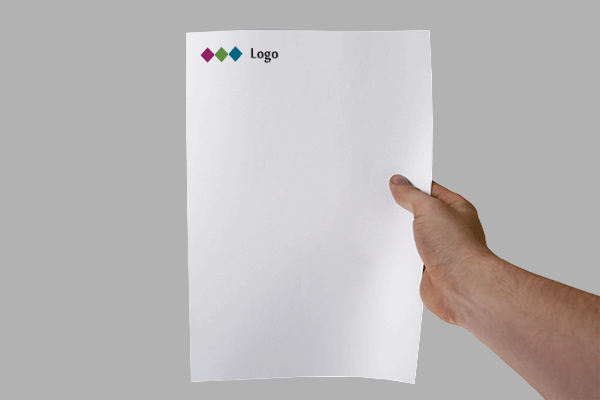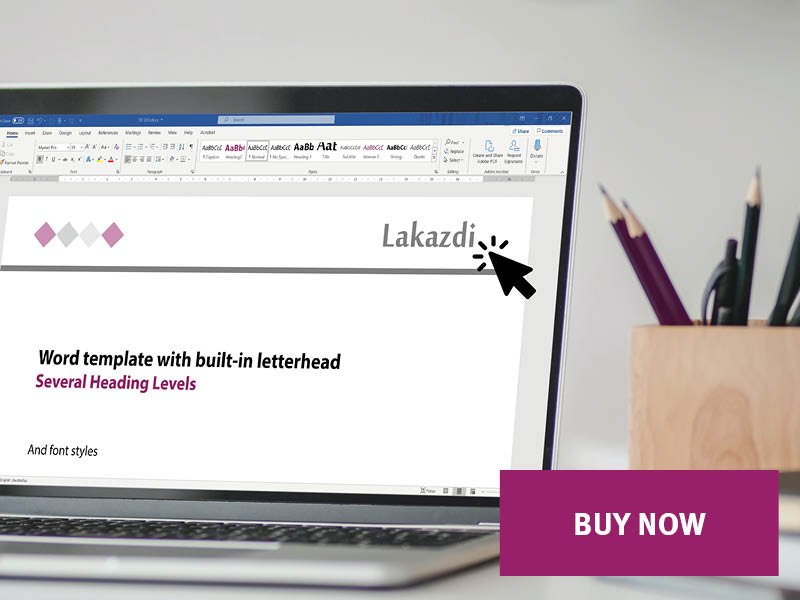 A letterhead is an important part of any official communication as it represents your brand or organization. It is the heading at the top of a sheet of paper, usually containing a company’s logo, name, address, and contact information. In this blog post, we will discuss the four essential elements that every effective letterhead should include.
A letterhead is an important part of any official communication as it represents your brand or organization. It is the heading at the top of a sheet of paper, usually containing a company’s logo, name, address, and contact information. In this blog post, we will discuss the four essential elements that every effective letterhead should include.
- Company Name and Logo: The company name and logo are the most important elements of a letterhead. They are the identity of your brand or organization and should be placed prominently on the top of the page. Ensure that your logo is clear and high-resolution to give your letterhead a professional look.
- Contact Information: Your letterhead should include your contact information, such as your physical address, phone number, email, and website. This information helps your recipients to contact you easily and quickly.
- Design and Colour Scheme: The design and colour scheme of your letterhead should reflect your brand or organization’s personality. Use colours that match your logo and keep the design simple and clean. Avoid using too many colours and patterns that can make your letterhead look cluttered and confusing.
- Tagline or Slogan: Adding a tagline or slogan to your letterhead can help to reinforce your brand message and create a lasting impression. Make sure your tagline is short, memorable, and relevant to your brand or organization.
Let’s go through these in more detail.
Company Name and Logo
 Your company name and logo are the most important elements of your letterhead. These two elements are what people will immediately associate with your brand. It’s essential to use a high-quality and clear logo on your letterhead to give it a professional and polished look.
Your company name and logo are the most important elements of your letterhead. These two elements are what people will immediately associate with your brand. It’s essential to use a high-quality and clear logo on your letterhead to give it a professional and polished look.
Your company’s name should be displayed in a clear and legible font that is easy to read. It should be placed prominently on the top of the page and be the largest text on the letterhead. When choosing a font, ensure it matches your brand’s personality and is consistent with other branding materials.
A logo is a visual representation of your brand, and it’s crucial to use a high-quality image on your letterhead. The logo should be clear, high-resolution, and recognizable, so it’s easily identifiable. It should also be displayed prominently on the letterhead, usually at the top, and should be slightly larger than the rest of the text.
When creating your logo, consider the colours you want to use. Colour psychology plays a vital role in branding and can evoke specific emotions and associations. Ensure that the colours you choose for your logo match your brand’s personality and values.
It’s also important to ensure that your logo and company name are positioned correctly on the letterhead. A well-designed letterhead should have a balanced layout that is easy on the eyes. Make sure there is enough white space around the logo and text to avoid a cluttered appearance.
Contact Information
 The contact information on your letterhead is just as important as your company name and logo. Your recipients will need to know how to get in touch with you, and including your contact information on your letterhead can make it easy for them to do so.
The contact information on your letterhead is just as important as your company name and logo. Your recipients will need to know how to get in touch with you, and including your contact information on your letterhead can make it easy for them to do so.
- Your physical address is an essential piece of information to include on your letterhead. It tells your recipients where you are located and can also help to build trust in your brand. Ensure that your address is complete and accurate, including the street address, city, state, and zip code.
- Your phone number is another critical piece of contact information to include on your letterhead. It allows your recipients to call you directly and can help to build a personal connection with your brand. Make sure that your phone number is easy to read and includes the area code.
- Your email address is another crucial piece of contact information to include on your letterhead. It’s a convenient way for your recipients to reach out to you, and it’s essential to ensure that your email address is professional and easy to read.
- Your website is an essential piece of information to include on your letterhead. It’s a valuable resource for your recipients to learn more about your brand, products, and services. Ensure that your website URL is complete and accurate, including the http or https prefix.
It’s important to ensure that your contact information is up-to-date and accurate. Check your physical address, phone number, email address, and website URL to ensure that they are correct before printing. Outdated contact information can make your brand look unprofessional and can cause frustration for your recipients.
Ensure that your contact information is placed prominently on your letterhead. It’s common to place your contact information at the bottom of the letterhead, below your company name and logo. However, you can also consider placing it in the header or footer of the page, depending on your design.
In summary, including your contact information on your letterhead is crucial to ensure that your recipients can easily get in touch with you. Ensure that your physical address, phone number, email address, and website URL are complete, accurate, and easy to read. Check your contact information to ensure that it’s up-to-date before printing your letterhead, and ensure that it’s placed prominently on the page. With a well-designed letterhead that includes your contact information, you can enhance your brand’s credibility and professionalism.
Design and Colour Scheme
 The design and colour scheme of your letterhead play a crucial role in communicating your brand’s personality and values to your audience. When creating your letterhead, it’s important to ensure that the design and colour scheme are consistent with your brand’s identity.
The design and colour scheme of your letterhead play a crucial role in communicating your brand’s personality and values to your audience. When creating your letterhead, it’s important to ensure that the design and colour scheme are consistent with your brand’s identity.
To start, consider your brand’s personality and values. Are you a serious and professional brand, or are you playful and creative? The design and colour scheme of your letterhead should reflect these characteristics.
One important element to consider is your brand’s logo. Your logo is a visual representation of your brand, and it should be prominently displayed. Use the colours from your logo as a basis for your letterhead’s colour scheme, as this will help to create a cohesive and visually appealing design.
When choosing colours for your letterhead, it’s important to be strategic. Stick to a few key colours that match your brand’s identity, rather than using too many colours that can make your letterhead look cluttered and confusing. If your brand has a specific colour palette, use those colours on your letterhead to maintain consistency across all your marketing materials.
In addition to colour, the overall design should be clean and simple. Avoid using too many patterns or graphics that can detract from your message. Instead, use negative space to create a clean and uncluttered design.
In summary, the design and colour scheme of your letterhead are important elements in communicating your brand’s personality and values to your audience. When designing your letterhead, consider your brand’s logo, colour palette, and overall design. Keep the layout clean and simple, and use a clear and legible font for all text. With a well-designed letterhead that reflects your brand’s identity, you can create a professional and cohesive image for your brand.
Tagline or Slogan
 Including a tagline or a short description of your brand on your letterhead can help to reinforce your brand’s message and personality. A tagline is a short and memorable phrase that captures the essence of your brand and can help to differentiate it from your competitors.
Including a tagline or a short description of your brand on your letterhead can help to reinforce your brand’s message and personality. A tagline is a short and memorable phrase that captures the essence of your brand and can help to differentiate it from your competitors.
When creating your tagline, consider your brand’s unique selling proposition (USP) and the emotions you want your brand to evoke in your audience. Your tagline should be memorable, catchy, and easy to remember.
Your tagline should also be consistent with your brand’s personality and values. If your brand is known for its humour, then your tagline should be witty and playful. If your brand is more serious, then your tagline should reflect that tone.
Your tagline should be placed prominently on the page, typically below your company name and logo. Ensure that your tagline is easy to read and complements the design of your letterhead.
In addition to a tagline, you can also consider including a short description of your brand on your letterhead. This description should be brief and to the point, highlighting the key features and benefits of your brand. It can help to give your recipients a quick snapshot of what your brand is all about.
When creating your brand description, focus on the unique selling points of your brand and what sets it apart from your competitors. Be sure to keep your description short and concise, so it doesn’t overwhelm your letterhead.
Like your tagline, your brand description should be consistent with your brand’s personality and values. It should also be placed prominently on your letterhead and complement the overall design of the page.
In summary, including a tagline or a short description of your brand on your letterhead can help to reinforce your brand’s message and personality. When creating your tagline or brand description, consider your brand’s unique selling proposition, personality, and values. Ensure that your tagline or brand description is placed prominently on your letterhead and complements the overall design of the page. With a well-designed letterhead that includes a tagline or brand description, you can enhance your brand’s credibility and communicate your brand’s message more effectively to your recipients.
What to include in your letterhead
In conclusion, a well-designed and informative letterhead can enhance your brand’s credibility and professionalism. By including your company name and logo, contact information, design and colour scheme, and tagline or slogan, you can create a letterhead that represents your brand or organisation effectively.
Letterheads are an essential part of your brand’s identity, and it’s crucial to use it consistently across all your communication channels. Ensure that your letterhead is aligned with your brand’s personality and values and is reflective of your brand’s overall aesthetic. This consistency will help to build trust and recognition with your audience over time.
It’s also important to consider the layout of your letterhead. Your company name, logo, and tagline should be prominently displayed at the top of the page. Contact information, such as your phone number and email address, should be easy to find and read. Use a clear and legible font for all text on your letterhead.
Finally, it’s a good idea to create a few different versions of your letterhead for different uses. For example, you may want to create a version that is suitable for printing on coloured paper or a version that is optimised for digital use.


